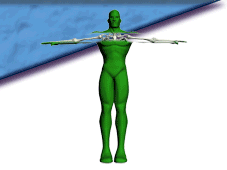The Most Common Cause of Shoulder Pain
Shoulder Impingement Tendinitis has many names: Impingement Syndrome, Painful Arc Syndrome, Swimmer's Shoulder, and Thrower's Shoulder to mention a few. Most people who develop this tendinitis (better called tendinosis due to lack of an inflammatory component- over 90% of all tendinopathies have no inflammation) are puzzled by the fact that they did nothing, as far as they know, to cause it. The reason this type of injury is so common is that it results from an imbalance caused by one or more of at least a dozen muscles. Imagine trying to get all twelve to act in agreement all the time. The chances are good that one or more won't go along with the program and the jury of twelve will be hung. Because this condition is not inflammatory cortisone only acts as an irritant. Shoulder Impingement Tendinitis can result from certain connective tissues becoming too weak or loose. Wikipedia researchers site that Prolotherapy is a good choice for this problem.
It has been postulated that the prevalence of shoulder tendinitis today is the result of: 1. the human condition- we are intrinsically manipulative creatures and this, along with our brain capacity, has maximal survival value for us; and 2. we are living much longer than our ancestors. Shoulder Impingement Tendinitis results from the fact that we do almost everything with our hands IN FRONT OF our bodies (and eyes), yet our rotator cuff tendons and scapular muscles are designed to need just as much strengthening with our arms being directed in a backward direction. When is the last time you did a text or set your watch with your hands behind your back? This situation of muscle imbalance will ultimately result in shoulder joint irritation without any single identifying trauma, although it also predisposes a person to this tendinitis following some trauma. Furthermore, it is common to see the imbalance transfer down the line causing uneven sharing of the load at the elbow, thus causing an elbow tendinitis (better called tendinosis). Repositioning and corrective exercise of the shoulder blade (scapular) muscles is essential in almost all Shoulder Impingement Tendinitis cases because the shoulder blade houses both the shoulder socket and the acromion, a large hood of bone that sits just above the rotator cuff and digs into it causing damage if it is tipped down as it commonly is in Shoulder Impingement Tendinitis.
While Shoulder Impingement Tendinitis is by far more common, the patient could present with a rotator cuff tear, usually a partial tear not requiring surgery. The corrective exercises and therapies are a bit different for this condition but generally work well and surgery is commonly ill-advised. Contrary to common belief an MRI is most often not necessary and rotator cuff tear and other related conditions can be identified by x-ray and by examination if the doctor knows what to look for. If any degree of partial or micro-tear is suspected, and conservative therapy and exercises are not providing steady improvement, a course of Prolotherapy should be considered to stimulate more rapid healing of the
Return to the Articles Page
Return to the Where's Your Pain? Page



